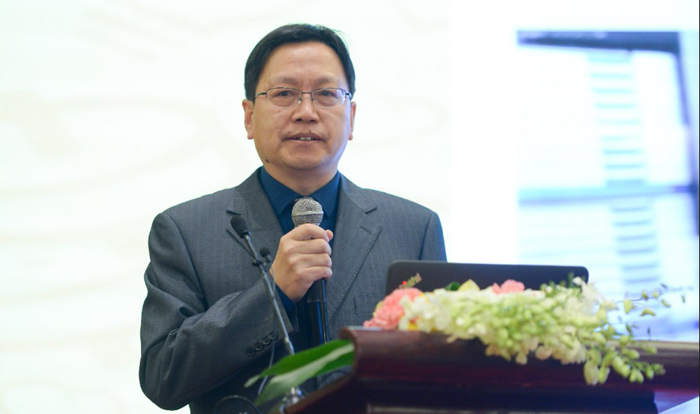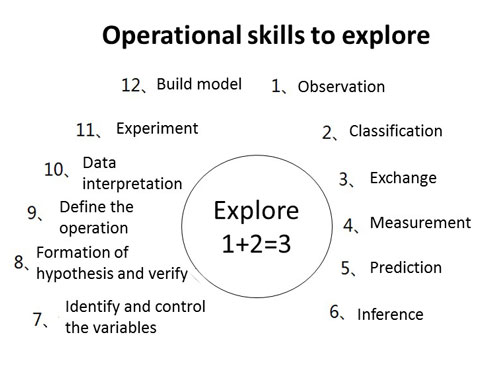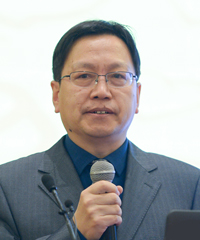Presented at the "First International Conference" of CRN Child Science Exchange Program in Asia held in Shanghai, China, March 4-5, 2017.
Definition and Background of the Large-Span Teaching Method
The Large-Span Teaching (Cross-sectoral) Method was first proposed by Dr. Xuesen Qian. To begin with, using the Large-Span working method, Dr. Xuesen Qian and his team researchers enabled the independent development of the first artificial satellite within a period of 20 years. Using the same approach, they established mind-body science, thinking science, educational thought and other theories, which led to outstanding practices. In 1978 Dr. Xuesen Qian was instrumental in the establishment of the National University of Defense Technology, and applied the Large-Span Teaching Method, regardless of discipline or departments. They worked together and developed the world's fastest computer at that time. This in turn enabled the rapid development of China's aviation systems, high-speed rail service, and biological sciences.
What is the Large-Span Teaching Method? Why should this method be implemented? The concept of Large-Span Teaching is a mode of education which severs the division between disciplines, fields, and departments in order to achieve the maximum effect of team-working in collaborating among these fields. The wider the scope of contact, the more abundant the effect of drawing inspiration, allowing insights, and creating more opportunities to inspire innovative thinking.

How to Use the Large-Span Teaching Method
According to China's "Early Learning and Development Guidelines for Children Aged 3 to 6 Years," the role of teachers in teaching methodology is mainly reflected in two aspects. One is discipline integration, and the other is multiangle relation. For example, Tsinghua University Kindergarten implements the discipline integration teaching method. They provide activities so that the children can experience five different aspects —i.e. health, language, science, society, and art—on one single theme. Whereas in Nanjing Normal University, they have developed a set of teaching methods for intelligent integration, where children understand, experience and operate things making use of eight intelligent fields.
Currently, Europe and the United States are putting emphasis on the integration of STEM (Science, Technology, Engineering, and Math) fields. Up to now, it has been mainly implemented in elementary and junior high schools.
Dr. Xuesen Qian once said: integration of five or eight fields is not enough. Currently, the social science and technology systems consist of approximately 11 fields. Accordingly, we have to integrate at least 11 fields. Subjects such as mathematics, nature, geography, architecture, military science, system science, thoughts, mind-body science, ethology, sociology, culture and arts, etc., are to be integrated.
For example, consider the Arabic numeral (number) 3. In mathematics it is the number 3, which indicates the quantity; in the natural sciences it may represent the amount of an object; in architecture, it may represent more than a number, but may represent buildings shaped similar to "3," bridges, and alcoves, etc.; in military science it can be thought of as a "3" shaped bow. This is to let children think and develop from various points of view, not to consider 3 as simply a mathematical unit, but allow the brain to accept various kinds of stimulus, resulting in a variety of links, so that the children's thinking becomes flexible.
Second, whether it is multiple intelligence, eight intelligent integration, or modern science and technology integration, there is a definite need to integrate multi-angle integration. You can perceive and receive experiences related to the numbers from different fields such as construction, military, cultural and other fields. 3 is not a mere number but is related to its surrounding things and matters, so we do not just connect the knowledge in tandem, but also in parallel in order to create a network. Teachers should perceive things in a multi-angled way of thinking to teach children not to think in a single way, but to develop their abilities to use their imagination. For instance: when 3 and 2 represent quantities or amounts, they are relatively small numbers, but 3 can also represent a large amount, such as grasping rice grains in the hand, the number 3 (3 handfuls) represents quite a large amount. On the other hand, all of us can say that 3 is greater than 2, and 3 can be replaced by "2 + 1" as an alternative. Or even in an anthropomorphic example; 3 and 2 argue who the elder brother is and who the younger brother is. 2 says, "I am the elder brother since I am in front and you stand behind." But 3 says, "I am a bigger number than you, so I am the elder brother." Our left brain recognizes the objective, on the other hand our right brain is used for imagination. Somehow, our imagination has a more important role than logical thinking. This is some of the search examples of the Large-Span Teaching Method.
Early Childhood Learning Methods: Using the Five Senses, Multi-Methods and in Multi-Fields
Learning methods in childhood are mainly directly perceived through our five senses. Children experience a wide variety of things using their bodies in multi-fields, and by trying different methods. How should the Large-Span Teaching Method be applied in early childhood education? First, let's consider learning through direct perception using the five senses. In today's lecture, Professor Kazuo Hiraki compared the learning effect on children when children are given two learning methods; one was face-to-face learning and the other was through video learning. The result showed that the face-to-face learning effect was better and just learning through video teaching would not give the expected effect. We have a question at this point. If, for instance, the teacher made himself smell like a tiger, the learning effect will not work. Why not? The sense of smell is activated in the brain, triggering the anxiety or fear to the children, so the learning effect certainly cannot be guaranteed. Why do we have to pay attention to our five senses? The sense of taste allows us to taste different kinds of bitterness, and by moving our hands and body in different ways, we might be able to sense things differently. With the sense of hearing, you may be able to hear the difference between the crying sounds of fear, exhaustion and hunger. Our educational aim through play is very clear—let children develop the ability to absorb information through their five senses, which will lead to establish their solid foundation for the development of children's intelligence.
Second, in the "Early Learning and Development Guidelines for Children Aged 3 to 6 Years," 12 kinds of methods are mentioned as a means for learning through hands-on experience. For instance, in order to make the children experience what 1 + 2 = 3 means at the supermarket, the following methods are used: observation, classification, exchange, measurement, prediction, inference and so on. If the number of the customers in the supermarket suddenly increases on a particular day, what will happen to the fruit stock? When figuring out if it will increase or decrease more and more, it is necessary to identify and decide the variables of both the fruit and customers. When presuming that the number of customers increase, the fruit stock will decrease, and it is necessary to verify the assumption. Then in regard of how to carry the fruit when purchasing, a watermelon is usually carried with both arms, but apples may be held in a single hand. We lead children to understand what it means to "carry in both hands" or to "hold in one hand," by explaining through body actions, with facial expressions, and through verbal language. Furthermore, data interpretation, experiment, building models, etc., are also included in the above-mentioned 12 kinds of methods, which are essential operations for scientific exploration. It is important for teachers to master these methods, so that children can acquire additional types of exploration skills and other new observation methods in accordance to their growth. (Figure 1)

Figure 1
It is also essential to develop children's creative skills. Take for example the number "3," by changing its form by imitating, increasing, decreasing, expanding, down-scaling, combining, breaking down, changing, or inverting, you can make 12 different forms of 3. For instance, suppose the teacher asks the children to make paper planes. At first, the teacher shows a drawing and the children imitate it, then, both the teacher and the children appreciate their works. The teacher may say, "The wings of your plane are wide, so it will definitely fly a long way," or "What can we do to seat more people?" Through the teacher's lead, the children can be encouraged to make different types of paper planes.
Finally, let's consider the multi-field experience. As a hands-on experience, suppose a child makes a toy crane. The need for the crane may be different depending on the user. What kind of crane is necessary for a dancer, what is its role? If he/she stands on a high level using the crane, the audience can see him/her. It functions for the dancer as a stage. But the crane can be used as a tool to save children for the Black Cat Detective (a cartoon character), while for monkeys, the crane can be used as a ladder to climb up and pick peaches. For a bird, the crane can be used to build a safe nest since it is in a high place. As you can see, the same crane can have different significance, depending on different occupations or different fields. Teachers should lead children to understand that the same thing in different fields can have different roles and meanings.
The Effect of Large-Span Teaching Method
The following are the main effects of this teaching method: First, is the establishment of an interconnected intelligence network. When focusing on one theme, the relevant knowledge in various fields becomes clear, producing connections or links with each other, through the integration of various academic disciplines. Dr. Xuesen Qian said that there are three points necessary when educating someone into an outstanding person. Firstly, in addition to being knowledgeable, his/her knowledge should be interconnected to build an intelligence network; Secondly, concrete thinking and abstract thinking should be developed in a well-balanced way to encourage new ideas; Thirdly, the development of emotions should be encouraged. Through discipline integration and multiangle relationships, the children's knowledge should be linked across different fields, culminating in the ability to analogize different things when given just one example. Stimulating the children's brain to activate its function is essential.
Furthermore, I would like to mention that Dr. Xuesen Qian's thinking science theory has had a major impact on our discipline of scientific development, and the discussion is still ongoing. Conventionally, we used to follow Jean Piaget's theory in China—i.e. first comes concrete thinking, which then leads to abstract thinking, and finally evokes innovation. Dr. Xuesen Qian said that concrete thinking and abstract thinking develop together like a pair of wheels. Up until 6 years-old, children's lives are based on concrete thinking, but after 6 years old, abstract thinking becomes essential. Nevertheless, some 3-4 year-olds may use abstract thinking rather than concrete thinking.
As seen in the visit we paid to a kindergarten to observe the children, the two methods of thinking develop in a well-balanced way in real life. More specifically, acknowledging a shape is processed in the right brain, while the abstract frame of mind belongs mainly to the left brain. The right and left sides of the brain do not develop in turn, but develop simultaneously in a coordinated way.
Teaching Reflection of the Large-Span Teaching Method
In the practical field of education, some teachers can only mention related matters in a row, and point out the relevance in tandem, but cannot let the children develop an affluent network of diverting intelligence. When teachers cannot lead children to develop sophisticated patterns of thinking, they are nowhere near coming up with an inspirational idea. Chinese people often ask children if they understand or not. When children say "I understand," it is actually the result of their thinking. So, how can we develop their ability to think for themselves in a way when given one example, come up with three different ideas in return?
First, establish children's developmental patterns of thinking in science using Dr. Xuesen Qian's theory of thinking science. The purpose of early childhood education is not to make children gain much knowledge. Knowledge is merely a "container" of information. Our aim is to nurture flexible ways of thinking in children through the container, and the process of play.
Secondly, teachers are required to transform their conventional way of thinking and accumulate more knowledge on how to teach children. We have been actively working on this through our compilation of "Large-Span Teaching Method."
Thirdly, goods and materials currently used at kindergartens are very monotonous. As a solution, we suggest finding materials which makes possible easy changes in shapes and colors, or different combinations, so that a wide variety of toys and teaching tools can be created.
Finally, I would like to explain the discussion on the theory of development for thinking. Ever since Jean Piaget's theory became present in the 1980s, many researchers have continued to study and flesh out this theory, including Maria Montessori. She also stressed that abstract thinking is necessary for the people living in the great industrial era. It was indispensable for the human resources demanded in the industrial revolution period. In 20 years from now, children aged 3-6 years old now may live in a society dominated by artificial intelligence. To face the change, as specialists involved in early childhood education, we are required to have great a foresight or the ability to make decisions, have our own ideas and accept the ever-changing theory of thinking development.



 Guoqiang Ren
Guoqiang Ren










